How to design an optimal solar PV system
Roll up your sleeves and learn how to design an optimal solar PV system. Get a perfect project layout easily with RatedPower.
- Published byMaïlys Babin
Maïlys Babin
9 Sep, 20 / UPDATED 31 May, 22
RatedPower is a platform that allows you to optimize your solar PV designs quickly and efficiently. In the last few months, we have implemented some game-changing improvements which have significantly reduced the simulation time and improved the structure grouping algorithm. These new parameters will help you make sure that your site is completely filled with structures to the most optimal design configuration.
In RatedPower, our aim has always been to ease and simplify the work of solar PV engineers through the automation of all the different tasks they perform on a daily basis. Since the start, our goal was for RatedPower's algorithm to focus greatly on certain aspects of the design of a PV plant. These include the automatic positioning of structures, roads, power stations, cables, and so on. Other important aspects are the calculation of cable cross-sections in accordance with different electrical standards, the energy production calculation, the substation engineering, and the generation of all the necessary documents and drawings related to each design.
This algorithm has always been and remains to be constantly evolving. We hope to shed light on some of the latest developments that the layout algorithm has experienced and guidance on how to optimize your design.
In this article, you will learn how to define some parameters that will help you optimize your PV plant, such as choosing the type of layout, defining the DC/AC ratio or sizing your equipment.
So, buckle up and enjoy the ride!
Structure Grouping Algorithm
Let's first take a look at the structure grouping algorithm where we have considered the importance of defining the way different blocks of structures are connected to a string box, inverter or power station.
With such a goal in mind, we have implemented a new update to our algorithm that ensures a more regular shape for these blocks. It does so by avoiding the creation of any stretched out blocks or ,in the case of complex sites, avoiding any blocks being divided between far areas. Resulting in an improved, more centered position of these blocks, with respect to the roads, thus saving you unnecessary, low voltage cables.
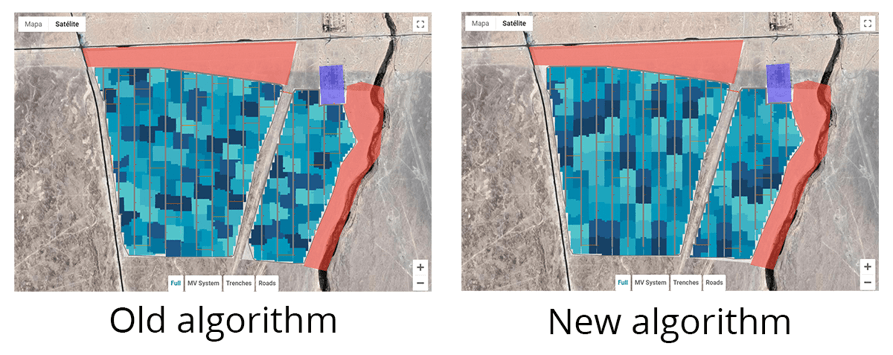
With the previous version of the algorithm, this process used to take an average of about 66 seconds. Now it takes a mere 0.6 seconds, bringing the total simulation time down to an average of 33 seconds.
This time reduction makes RatedPower's iterative process quicker and simpler while still providing you with a great level of detail in your simulations.
Generate multiple designs
If you want to make sure you’re producing the most optimal plant, don’t fret, we have integrated a new tool to generate multiple designs at once. By doing so, RatedPower will generate up to 10 designs simultaneously, while varying their inputs over the pitch distance and/or DC/AC ratio. We give you the power to review all your generated designs, select the best one, and use it for another batch of multiple designs to iteratively create your perfect PV plant!
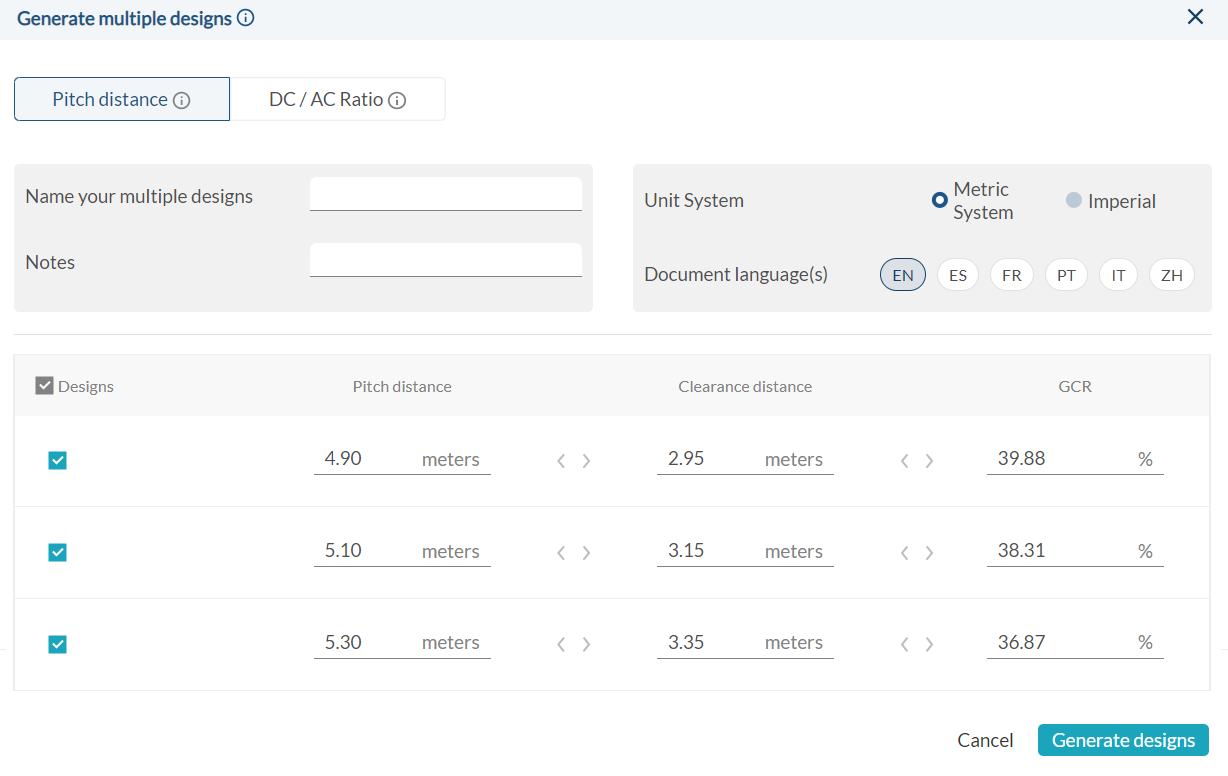
How can a solar developer optimize their PV plant projects at the very early stages? Watch our recorded webinar session, Early-stage PV project optimization: a developer POV, to find out!
Layout Parameters and Optimization
You have at your disposal numerous layout parameters that you can play with so you can visualize in real-time how they affect the final layout result.
Here’s how to use these layout parameters to get the most out of them:
Type of Layout
First, you can select the type of layout you want among the following options:
Regular blocks: this option defines a rectangular block of structures belonging to one power station and repeats it throughout the whole layout. This layout configuration is better for big PV plants with regular area definitions.
Adaptive design: with this option, each power station (PS) can have different sizes (power) and different DC/AC Ratio so the design complies with the global parameters set by the user. Using adaptive design allows the user to have power stations with different shapes that fit better with the perimeter and to the irregularities of the site and resulting in more total installed capacity.
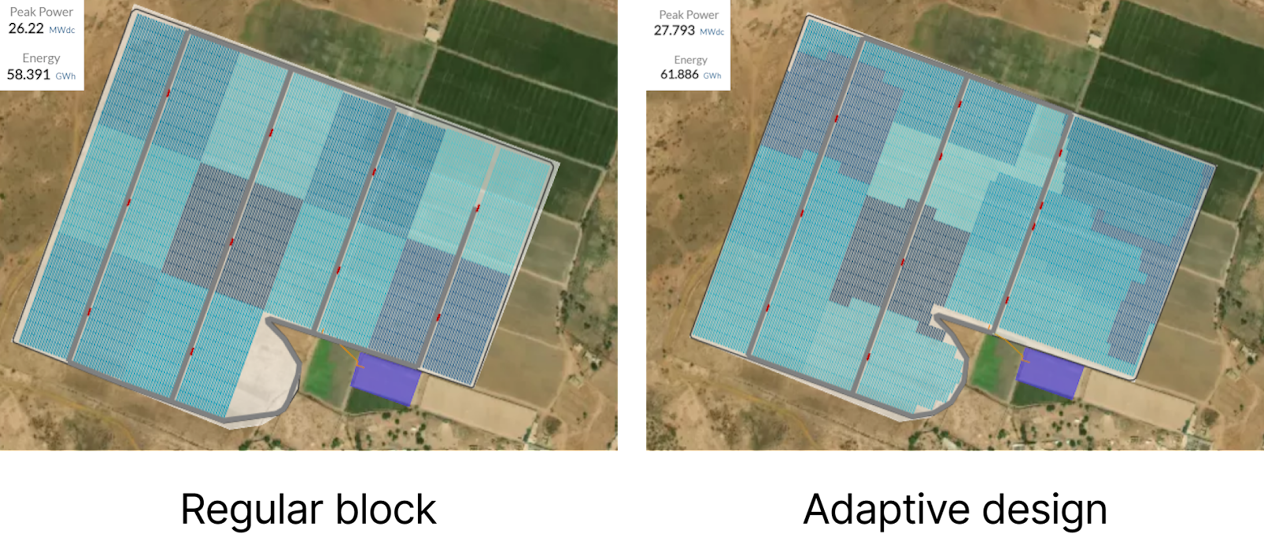
DC/AC Ratio
The Layout design tab allows you to define the DC/AC ratio. This ratio depends primarily on the PV module, the inverter, and the structure that you have chosen. In addition, other parameters such as the number of modules per string, strings per structure and structures per inverter will influence this ratio as well.
You can also enable the “Install the maximum peak power” check box. By activating this option all possible structures will be installed in the PV plant, reaching the maximum possible peak power by varying the DC/AC ratio of a maximum of +/-0.15.

Using Secondary Inverters
Another option to consider when trying to fill in those remaining portions where the chosen inverter cannot fit in, is to utilize a smaller, secondary inverter. When no more power stations can be placed on the site (size-wise), this option will allow you to try to place smaller power stations using the secondary inverter.
Setbacks
In order to have a more personalized layout, you can define several setbacks between the different elements: These are the setbacks that can be defined:
Available Area (AA) to fence
Restricted Area (RA) to fence
Power Station (PS) to structure
Power Station (PS) to road
Structure to road
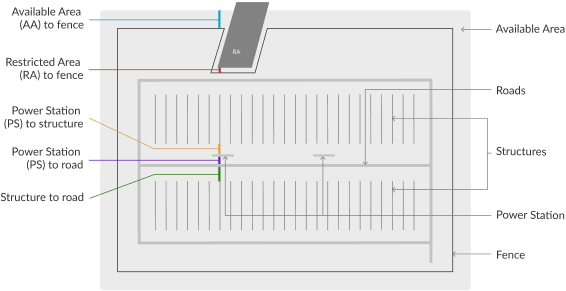
Structure position
Here you can choose to rotate or offset your structures, thus optimizing the layout with respect to the parcel’s borders.
You have four options to choose from:
Standard: structures will follow their usual axis direction.
Rotated: structures are rotated in blocks.
Offset: rotates the axis of the block while keeping the structures aligned.
Turning angle axis: structures are rotated while keeping the block aligned.
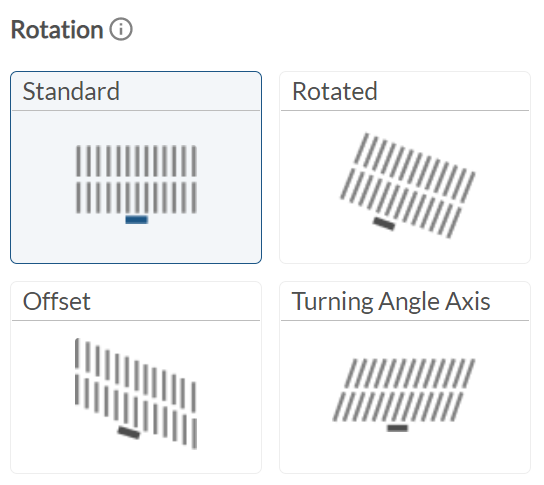
In the case of linked-row trackers, the last two options are not available.
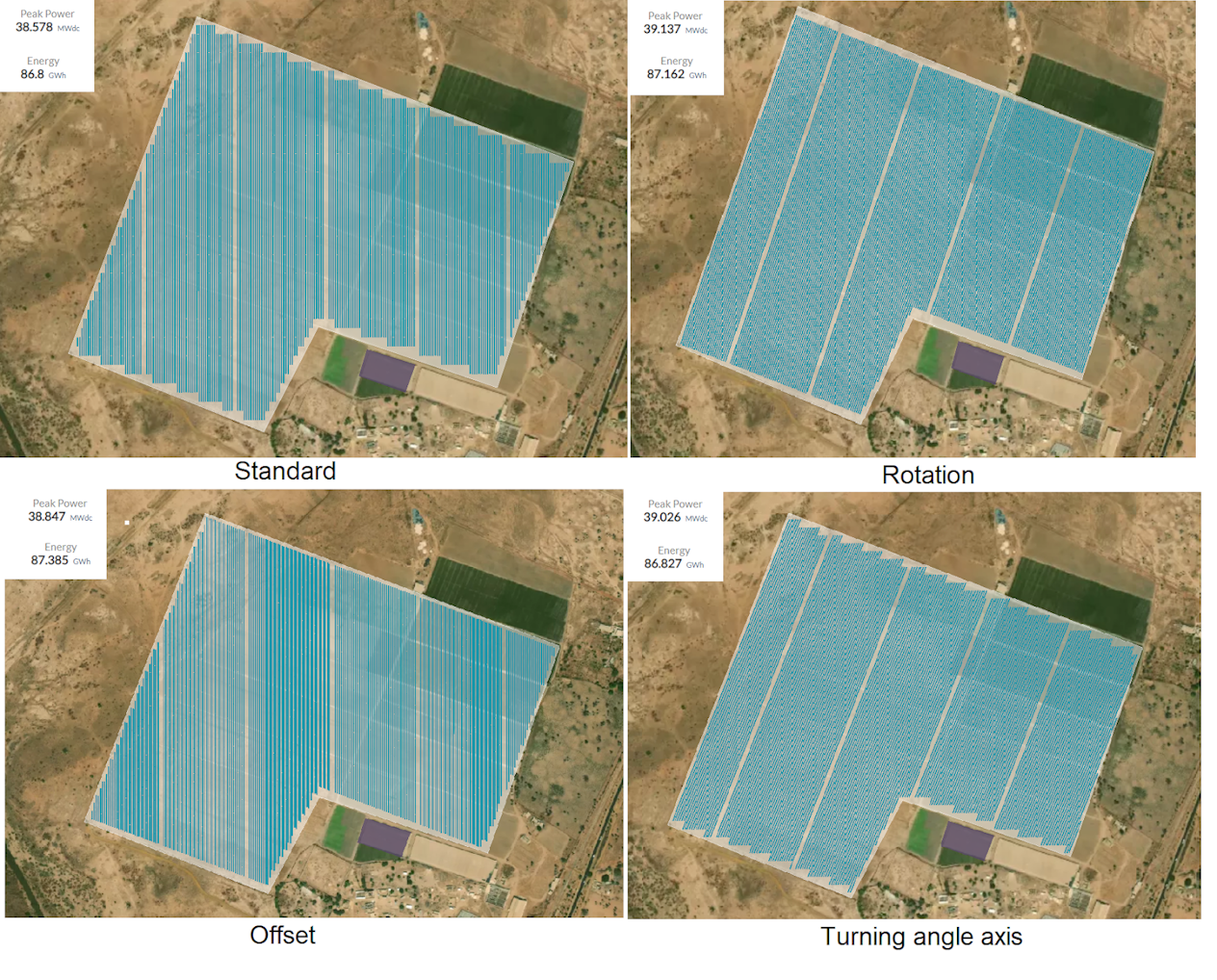
Using smaller structures
When your site is too small or with a lot of irregularities, in order to fit more structures you can use smaller ones. To do so, you need to reduce the number of modules per row. Two parameters in RatedPower will influence this value: the number of modules per string and the number of strings per structure. For trackers, you can also choose smaller structures (with less modules per row).
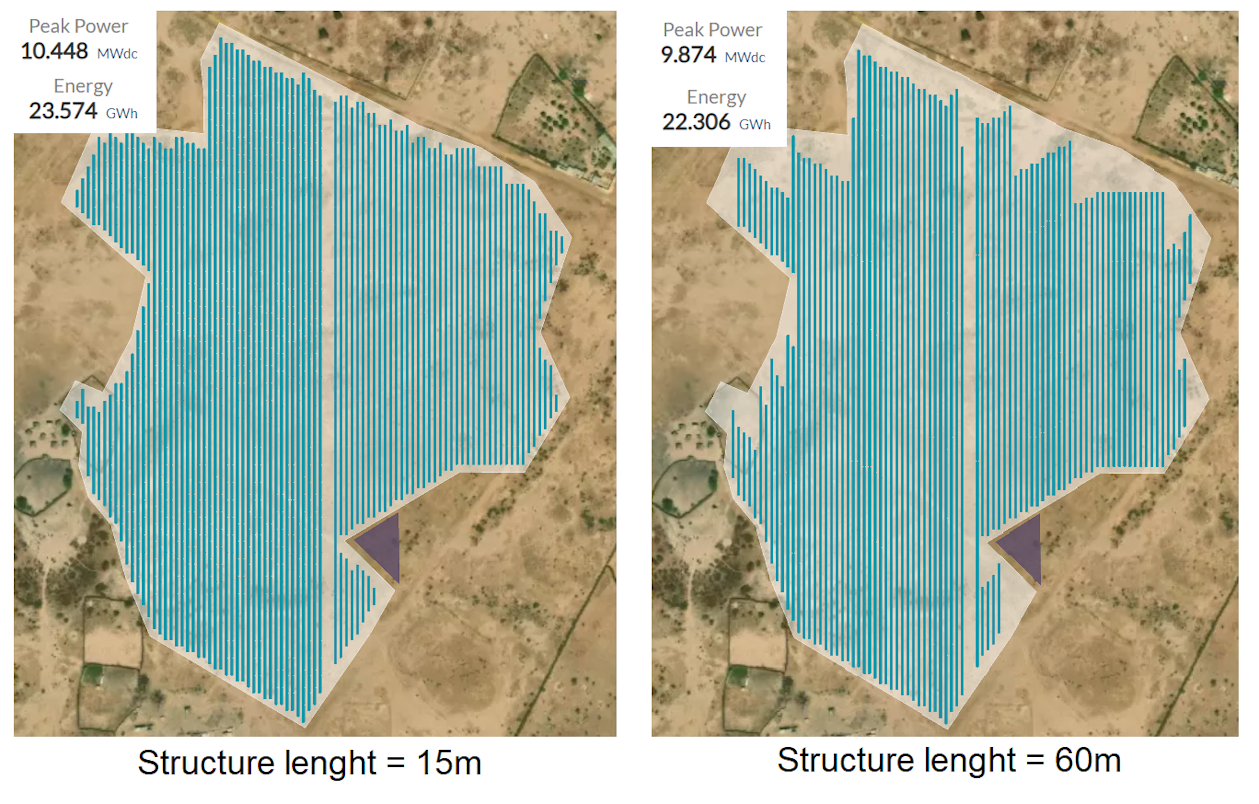
Power stations
You can select one of two options for the positioning of your power stations.

Placing the power station inside the DC field will take out one structure from the block connected to it but will result in shorter distances between structures and thus in general more total installed capacity.
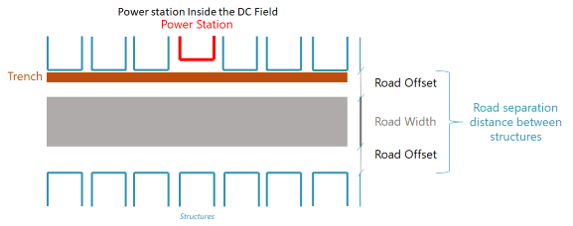
Roads
There are currently four road options in RatedPower:

Based on the needs of your PV plant, you can select one of the above options. The two possibilities without perimeter roads install PV modules all the way till the border of your parcel thus allowing you to install more total capacity.
Only horizontal roads: The route of the roads will connect all the Power Stations following an East-West direction to the access points of the plots.
Horizontal and perimeter roads: The route of the roads will connect all the Power Stations following an East-West direction and the perimeter roads to the access points of the plots.
Only vertical roads: The route of the roads will connect all the Power Stations following a North-South direction to the access points of the plots.
Vertical and perimeter roads: The route of the roads will connect all the Power Stations following a North-South direction and the perimeter roads to the access points of the plots.
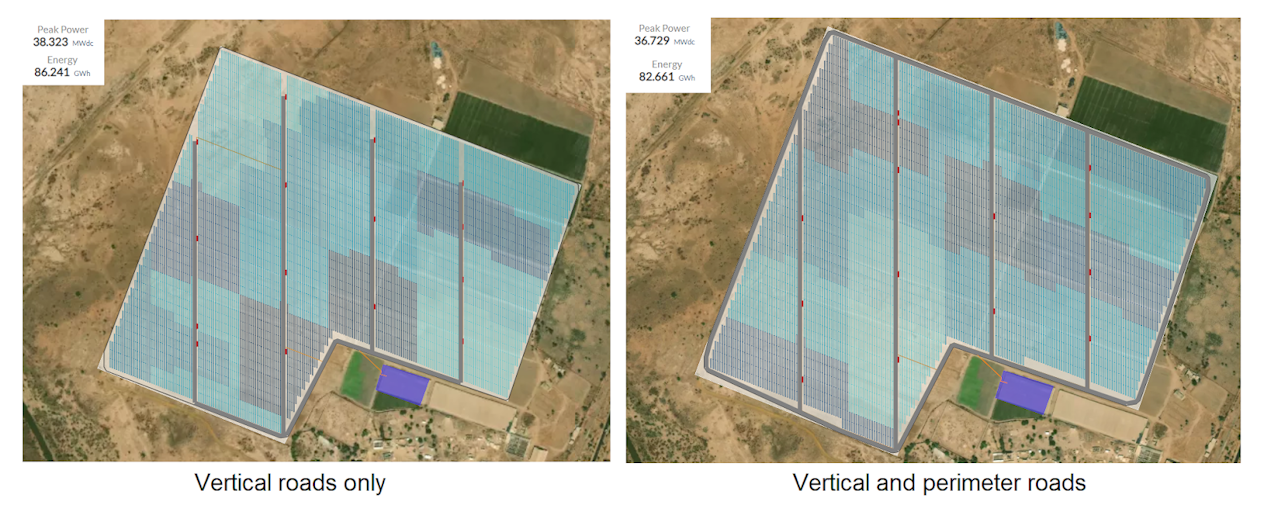
Structure alignment
Here, you can opt between two options:

This parameter gives you the option to decide between a linear uniform positioning of the structures or adapting your structures to the parcel’s border. On one hand the border adaptation helps increase the total capacity, however, by being more irregular it means that it is more complex to construct.
Your choice of horizontal or vertical roads will also affect this parameter because this border adaptation will only take effect when said roads are parallel to your structures’ axes. Thus, this will be enabled for vertical roads with trackers or east-west structures or for horizontal roads with fixed structures.
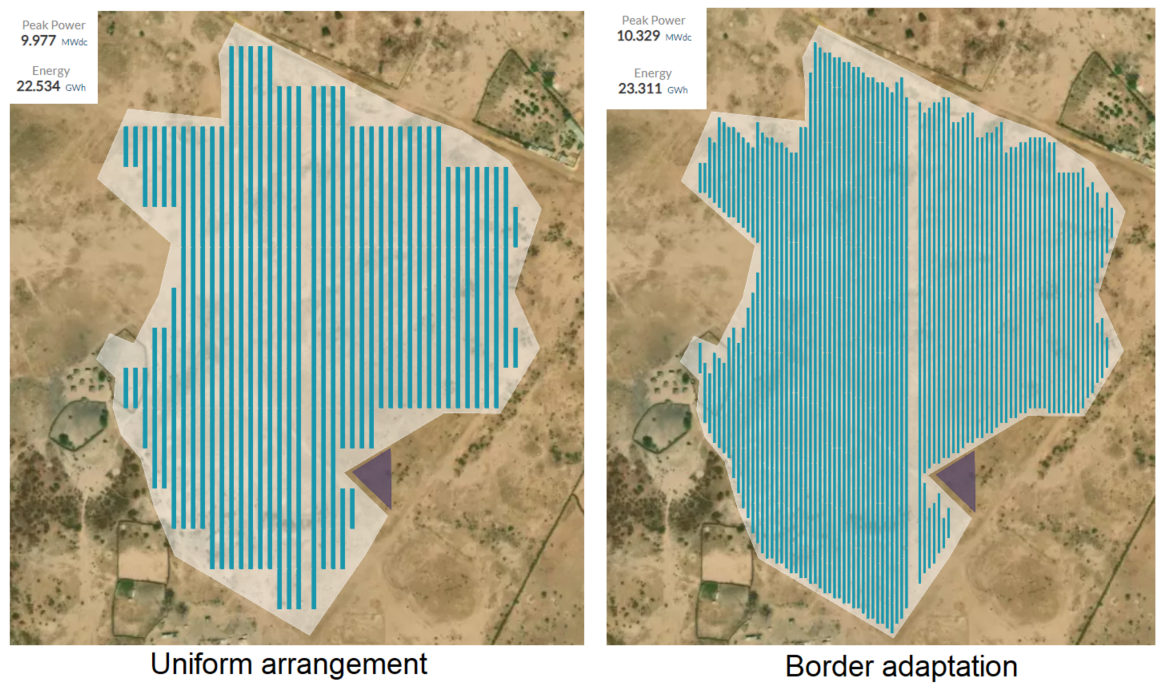
Final tweaks of your design
As discussed above, several relevant design configurations have been developed which enable you to tweak your design to perfection! For even more tips, check out our latest blog about the tilt angle for fixed structures for higher system efficiency. Another parameter to take into account is the pitch distance which influences not only the ground coverage ratio but also the shading losses
What you should do now
Whenever you’re ready, here are 4 ways we can help you grow your solar business and reduce LCOE of your PV plants.
- Get hands-on with a free RatedPower self-service guided tour. If you’d like to learn the ins and outs of how top photovoltaic software can help your engineering team, go ahead and request your free demo. One of our solar experts will understand your current design and engineering workflows, and then suggest practical tips on how to speed up them though the right tool.
- Let's get physical, physical! Learn the latest on renewable energy and PV in the second edition of Pulse, our annual get-together full of technical workshops, inspiring talks from energy leaders and tons of networking. Learn more.
- If you’d like to learn insights, ideas and inspiration for the low-carbon energy transition for free, go to our blog or visit our resources section, where you can download guides, templates and checklists solar successful pros use.
- If you’d like to work with other passionate experts on our team, or learn more about our purpose and corporate values, then see our Careers page.
- If you know another solar designer, developer or engineer who’d enjoy reading this page, share it with them via email, LinkedIn or Twitter.
Related posts
Searching results
